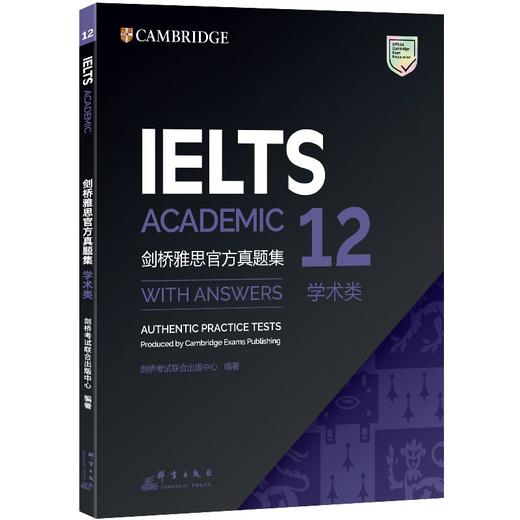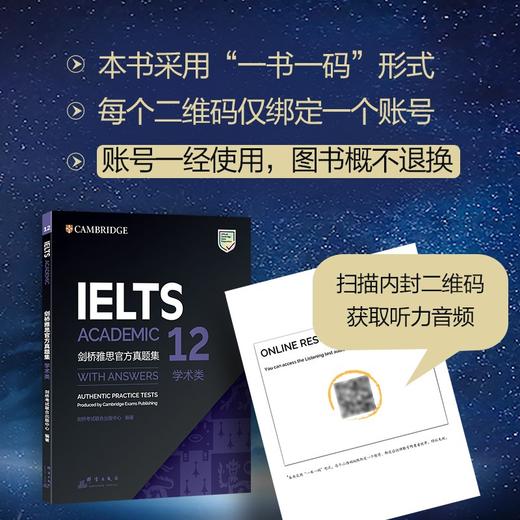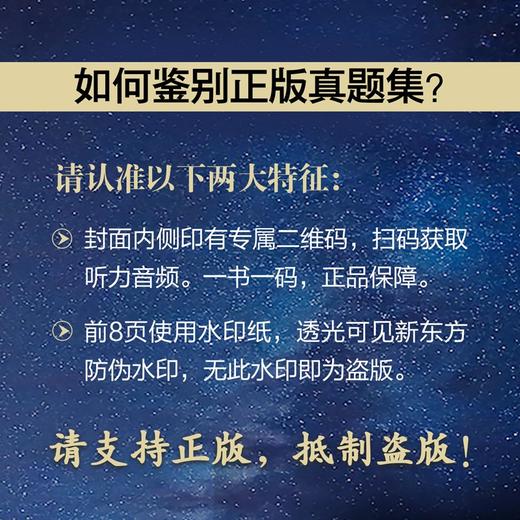商品详情

本书由以下内容构成:
● 4套完整的学术类雅思全真试题
● 各种题型的全面介绍以及剑桥大学考试委员会采用的评分系统解析
● 试题答案及听力录音文本
● 考生作文及考官点评
扫描封面内侧二维码,在线使用听力题目音频。本书采用“一书一码”防伪形式,每个二维码仅绑定一个账号。一经绑定,听力音频资源仅供账号所有者在线使用,转让无效。

剑桥考试联合出版中心(Cambridge Exams Publishing)是由剑桥大学出版社和剑桥大学英语考评部共同成立的。
剑桥大学出版社(Cambridge University Press):剑桥大学出版社是出版剑桥大学考试委员会各类考试(包括雅思)历届考试真题的官方指定出版社。
剑桥大学英语考评部(Cambridge Assessment English):隶属于剑桥大学考试委员会,拥有100多年的语言教学和测评经验,在130多个国家提供一系列学术、职业和技能的证书考试,在世界范围内得到了移民机构、教育机构、政府及企业的广泛认可。

Introduction 4
Test 1 10
Test 2 30
Test 3 53
Test 4 74
Audioscripts 95
Listening and Reading Answer Keys 116
Sample answers for Writing tasks 124
Sample answer sheets 132
Acknowledgements 136
Prepare for the exam with practice tests from Cambridge
Inside you’ll find four authentic examination papers from Cambridge Assessment English. They are the perfect way to practise – EXACTLY like the real exam.
Why are they unique?
All our authentic practice tests go through the same design process as the IELTS test. We check every single part of our practice tests with real students under exam conditions, to make sure we give you the most authentic experience possible.
Students can practise these tests on their own or with the help of a teacher to familiarize themselves with the exam format, understand the scoring system and practise exam technique.
Further information
IELTS is jointly managed by the British Council, IDP: IELTS Australia and Cambridge Assessment English. Further information can be found on the IELTS official website at: ielts.org.
WHAT IS THE TEST FORMAT?
IELTS consists of four components. All candidates take the same Listening and Speaking tests. There is a choice of Reading and Writing tests according to whether a candidate is taking the Academic or General Training module.
AcademicFor candidates wishing to study at undergraduate or postgraduate levels, and for those seeking professional registration. General TrainingFor candidates wishing to migrate to an English_speaking country (Australia, Canada, New Zealand, UK), and for those wishing to train or study at below degree level.
The test components are taken in the following order:
Listening4 parts, 40 items approximately 30 minutesAcademic Reading3 sections, 40 items60 minutesorGeneral Training Reading3 sections, 40 items60 minutesAcademic Writing2 tasks60 minutesorGeneral Training Writing2 tasks60 minutesSpeaking11 to 14 minutesTotal Test Time2 hours 44 minutes
ACADEMIC TEST FORMAT
Listening
This test consists of four parts, each with ten questions. The first two parts are concerned with social needs. The first part is a conversation between two speakers and the second part is a monologue. The final two parts are concerned with situations related to educational or training contexts. The third part is a conversation between up to four people and the fourth part is a monologue.
A variety of question types is used, including: multiple choice, matching, plan/map/diagram labelling, form completion, note completion, table completion, flow_chart completion, summary completion, sentence completion, short_answer questions.
Candidates hear the recording once only and answer the questions as they listen. Ten minutes are allowed at the end for candidates to transfer their answers to the answer sheet.
Reading
This test consists of three sections with 40 questions. There are three texts, which are taken from journals, books, magazines and newspapers. The texts are on topics of general interest. At least one text contains detailed logical argument.
A variety of question types is used, including: multiple choice, identifying information (True/False/Not Given), identifying writer’s views/claims (Yes/No/Not Given), matching information, matching headings, matching features, matching sentence endings, sentence completion, summary completion, note completion, table completion, flow_chart completion, diagram label completion, short_answer questions.
Writing
This test consists of two tasks. It is suggested that candidates spend about 20 minutes on Task 1, which requires them to write at least 150 words, and 40 minutes on Task 2, which requires them to write at least 250 words. Task 2 contributes twice as much as Task 1 to the Writing score.
Task 1 requires candidates to look at a diagram or some data (graph, table or chart) and to present the information in their own words. They are assessed on their ability to organise, present and possibly compare data, describe the stages of a process, describe an object or event, or explain how something works.
In Task 2 candidates are presented with a point of view, argument or problem. They are assessed on their ability to present a solution to the problem, present and justify an opinion, compare and contrast evidence and opinions, and evaluate and challenge ideas, evidence or arguments.
Candidates are also assessed on their ability to write in an appropriate style. More information on assessing the Writing tests, including the Writing assessment criteria (public version), is available on the IELTS website.
Speaking
This test takes between 11 and 14 minutes and is conducted by a trained examiner. There are three parts:
Part 1
The candidate and the examiner introduce themselves. Candidates then answer general questions about themselves, their home/family, their job/studies, their interests and a wide range of similar familiar topic areas. This part lasts between four and five minutes.
Part 2
The candidate is given a task card with prompts and is asked to talk on a particular topic. The candidate has one minute to prepare and they can make some notes if they wish, before speaking for between one and two minutes. The examiner then asks one or two questions on the same topic.
Part 3
The examiner and the candidate engage in a discussion of more abstract issues which are thematically linked to the topic in Part 2. The discussion lasts between four and five minutes.
The Speaking test assesses whether candidates can communicate effectively in English. The assessment takes into account Fluency and Coherence, Lexical Resource, Grammatical Range and Accuracy, and Pronunciation. More information on assessing the Speaking test, including the Speaking Assessment Criteria (public version), is available on the IELTS website.
HOW IS IELTS SCORED?
IELTS results are reported on a nine_band scale. In addition to the score for overall language ability, IELTS provides a score in the form of a profile for each of the four skills (Listening, Reading, Writing and Speaking). These scores are also reported on a nine_band scale. All scores are recorded on the Test Report Form along with details of the candidate’s nationality, first language and date of birth. Each Overall Band Score corresponds to a descriptive statement which gives a summary of the English language ability of a candidate classified at that level. The nine bands and their descriptive statements are as follows:
9Expert User - Has fully operational command of the language: appropriate, accurate and fluent with complete understanding.
8Very Good User - Has fully operational command of the language with only occasional unsystematic inaccuracies and inappropriacies. Misunderstandings may occur in unfamiliar situations. Handles complex detailed argumentation well.
7Good User - Has operational command of the language, though with occasional inaccuracies, inappropriacies and misunderstandings in some situations. Generally handles complex language well and understands detailed reasoning.
6Competent User - Has generally effective command of the language despite some inaccuracies, inappropriacies and misunderstandings. Can use and understand fairly complex language, particularly in familiar situations.
5Modest User - Has partial command of the language, coping with overall meaning in most situations, though is likely to make many mistakes. Should be able to handle basic communication in own field.
4Limited User - Basic competence is limited to familiar situations. Has frequent problems in understanding and expression. Is not able to use complex language.
3Extremely Limited User - Conveys and understands only general meaning in very familiar situations. Frequent breakdowns in communication occur.
2Intermittent User - No real communication is possible except for the most basic information using isolated words or short formulae in familiar situations and to meet immediate needs. Has great difficulty understanding spoken and written English.
1Non User - Essentially has no ability to use the language beyond possibly a few isolated words.
0Did not attempt the test - No assessable information provided.
- 新华一城书集 (微信公众号认证)
- 上海新华书店官方微信书店
- 扫描二维码,访问我们的微信店铺
- 随时随地的购物、客服咨询、查询订单和物流...













